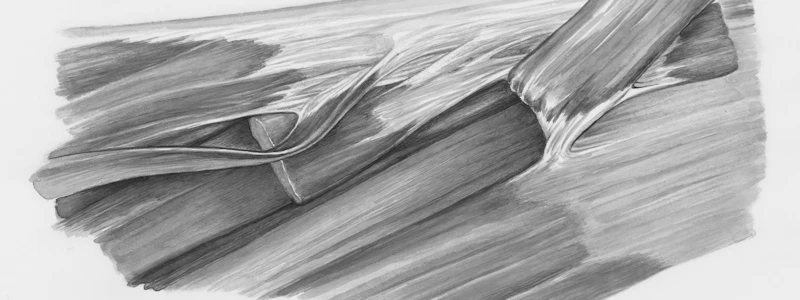Podcast
Questions and Answers
Which of the following is the most direct consequence of reproductive isolation between two populations?
Which of the following is the most direct consequence of reproductive isolation between two populations?
- A reduction in competition for resources.
- The occurrence of identical mutations in both populations.
- Speciation, where the two populations can no longer interbreed and produce viable, fertile offspring. (correct)
- Increased genetic drift within each population.
A paleontologist discovers a fossil of an extinct mammal. Upon examining its bone structure, they identify a modified radius and ulna that appear similar to those found in modern bats. What evolutionary concept does this exemplify?
A paleontologist discovers a fossil of an extinct mammal. Upon examining its bone structure, they identify a modified radius and ulna that appear similar to those found in modern bats. What evolutionary concept does this exemplify?
- Vestigial structures indicating a loss of function.
- Physical adaptations arising from artificial selection.
- Homologous structures suggesting common ancestry. (correct)
- Analogous structures due to convergent evolution.
In an environment with a fluctuating food supply, which combination of traits would likely be favored by natural selection?
In an environment with a fluctuating food supply, which combination of traits would likely be favored by natural selection?
- High variation within the population, low birth rate, and specialized diet.
- Low variation within the population, low birth rate, and generalized diet.
- Low variation within the population, high birth rate, and specialized diet.
- High variation within the population, high birth rate, and generalized diet. (correct)
Which of the following accurately describes the functional difference between a nerve and a spinal cord?
Which of the following accurately describes the functional difference between a nerve and a spinal cord?
Consider a cladogram illustrating the evolutionary relationships among several species. Which statement correctly interprets the information presented in the cladogram?
Consider a cladogram illustrating the evolutionary relationships among several species. Which statement correctly interprets the information presented in the cladogram?
Flashcards
Dorsal
Dorsal
Toward the back (think backbone).
Ventral
Ventral
Toward the belly or front side.
Anterior
Anterior
Toward the head or front.
Posterior
Posterior
Signup and view all the flashcards
Open Circulatory System
Open Circulatory System
Signup and view all the flashcards
Study Notes
- Anatomy/Evolution Test Topics
Anatomical Orientation
- Dorsal refers to the back or upper side of an organism.
- Ventral refers to the front or lower side of an organism.
- Anterior refers to the front.
- Posterior refers to the back.
Circulatory Systems
- Open circulatory systems pump blood into a hemocoel with the blood diffusing back to the circulatory system between cells.
- Closed circulatory systems have the blood closed at all times within vessels of different size and wall thickness.
Body Temperature Regulation
- Cold-blooded animals cannot regulate their body temperatures.
- Warm-blooded animals maintain a constant body temperature.
Body Plan
- Bilateral symmetry is when the body can be divided into two identical halves.
Body Systems
- The nervous system's main function is to transmit signals between the brain and the rest of the body, including internal organs.
Reproduction
- Sexual reproduction in the animal kingdom provides genetic diversity.
Organ Functions
- Esophagus transports food from the mouth to the stomach.
- Intestines are responsible for absorbing nutrients from food.
- The brain controls bodily functions and behavior.
- A 3-chambered heart has two atria and one ventricle.
- A 4-chambered heart has two atria and two ventricles.
- Endoskeletons are internal support structures.
- Exoskeletons are external support structures.
- Testes produce sperm.
- Ovaries produce eggs.
- Nerves transmit signals throughout the body.
- The spinal cord relays signals between the brain and body.
- Kidneys filter waste from the blood.
- Lungs facilitate gas exchange.
Classification
- Taxonomy is the science of classifying organisms.
- Phylogeny is the evolutionary history of a species or group of species.
- A cladogram is a branching diagram that shows the evolutionary relationships among organisms.
- Dichotomous keys are tools used to identify organisms based on their characteristics.
Adaptations
- Physical adaptations are structural features that enhance survival.
- Behavioral adaptations are actions that enhance survival.
Evolution
- Natural selection is the process by which organisms better adapted to their environment tend to survive and reproduce more successfully.
- Natural selection is a naturally occurring process, while artificial selection is human-driven.
- Species refers to a group of living organisms consisting of similar individuals capable of exchanging genes or interbreeding.
- Speciation is the evolutionary process by which populations evolve to become distinct species.
- Isolation that leads to speciation can increase biodiversity.
- Genetic change includes recombination and mutation.
- Homologous structures come from common ancestry.
- A vestigial trait is an evolutionarily remnant of a structure that served a purpose in the organism's ancestors.
- Overproduction, competition, and variation are factors in evolution.
Studying That Suits You
Use AI to generate personalized quizzes and flashcards to suit your learning preferences.




